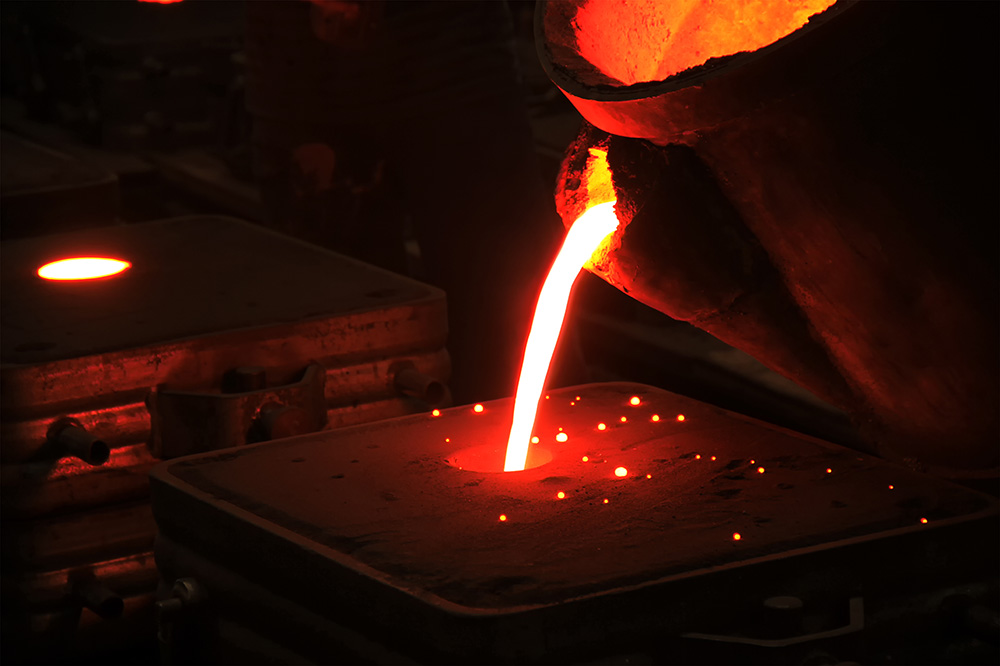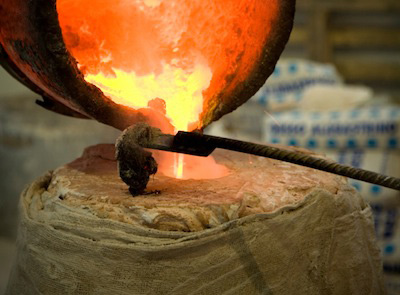Understanding the Metal Castings Process: A Comprehensive Overview for Beginners
The Metal Casting process is a basic technique in making that transforms molten metal right into strong kinds. Newbies need to understand the numerous techniques entailed, such as sand spreading and pass away spreading. Comprehending the products, style concepts, and safety and security steps is similarly essential. Each element plays a vital duty in accomplishing successful outcomes. As one navigates these intricacies, the inquiry of how to optimize each action for boosted outcomes becomes significantly important.
The Essentials of Steel Casting
Although Metal Casting has actually progressed over centuries, its essential concepts continue to be regular and indispensable to the manufacturing process. At its core, Metal Casting involves the makeover of liquified metal right into strong things with numerous methods. The procedure starts with the creation of a mold and mildew, which defines the shape of the final item. As soon as the mold and mildew is prepared, metal is heated to its melting factor and put into the tooth cavity. After cooling down, the metal strengthens, taking the shape of the mold.
There are several casting methods, consisting of sand casting, financial investment spreading, and die spreading, each with distinct advantages and applications. The choice of method depends on variables such as manufacturing quantity, material kind, and preferred accuracy. Once cast, the end product might undergo added processes like machining or surface area treatment to accomplish the required finish and specifications. Recognizing these basics is important for anyone curious about the field of Metal Casting.

Recognizing Products Made Use Of in Steel Casting
Materials play an essential role in the Metal Casting process, affecting the end product's residential properties and performance. Different steels are used, consisting of aluminum, iron, steel, and bronze, each offering distinct qualities matched for certain applications. Aluminum is light-weight and corrosion-resistant, making it perfect for vehicle components. Iron, specifically cast iron, is favored for its outstanding wear resistance and sturdiness. Steel gives high toughness and convenience, commonly used in hefty equipment components. Bronze, recognized for its deterioration resistance and machinability, is typically employed in marine applications.
In addition to the metals, numerous casting materials, such as sand, plaster, and ceramic, are used to develop mold and mildews. Sand spreading, the most widespread technique, uses silica sand because of its thermal security and capacity to develop complex shapes. Plaster and ceramic molds offer better details yet may need even more complicated processes. The selection of products directly affects the effectiveness, cost, and quality of the casting procedure.
The Style Refine: From Principle to Plan
The design process in Metal Casting begins with the initial concept development, where concepts are generated and evaluated. This is adhered to by the application of CAD modeling methods, allowing for accurate visualizations of the layout. The plan completion steps assure that all specifications are precisely recorded for manufacturing.
First Idea Development
First concept advancement marks a crucial phase in the Metal Casting process, where concepts change right into substantial styles. During this phase, designers team up with engineers and stakeholders to brainstorm and fine-tune first principles. They consider aspects such as functionality, appearances, and manufacturability, making certain that the design meets the needed requirements and efficiency criteria. Sketches and harsh drafts are created to picture the principles, enabling for initial evaluations of expediency and cost-effectiveness. This stage also entails recognizing products and potential spreading methods that align with the design goals. Inevitably, preliminary principle growth prepares for a thorough blueprint, directing the succeeding stages of the spreading process and guaranteeing an effective shift from idea to truth.
CAD Modeling Techniques
Transforming concepts right into specific designs, CAD modeling strategies play a pivotal duty in the Metal Casting process. These techniques make use of innovative software application to create detailed three-dimensional versions that properly reflect the designated product. By utilizing tools such as parametric modeling, solid modeling, and surface area modeling, developers can control measurements and forms effortlessly. CAD systems likewise help with simulation and analysis, enabling the recognition of prospective imperfections prior to production starts. This proactive method lowers material waste and maximizes the style for manufacturability. Furthermore, CAD versions can be quickly customized, allowing fast models based upon comments. Basically, CAD modeling functions as the backbone of the design process, linking the void in between initial concepts and the ultimate production-ready designs.
Plan Completion Steps
Adhering to the production of comprehensive CAD models, the next stage includes plan completion, which is crucial in equating electronic styles into actionable plans for production. This process starts with evaluating the CAD models for precision and compliance with specifications. When verified, the measurements, resistances, and product specs are diligently described to assure clarity. Integrating notes and annotations assists interact vital details relating to spreading processes, surface area finishes, and setting up demands. The finalized blueprint undertakes an extensive authorization process, frequently involving partnership with engineers and manufacturing teams to deal with any type of potential problems. Revisions are made and authorizations gotten, the blueprint is formally launched, offering as the foundational file for the subsequent phases of Metal Casting, including pattern making and mold style.
The Metal Casting Strategies Explained

Metal Casting techniques encompass a selection of techniques utilized to shape liquified metal into desired kinds. These methods vary according to the kind of material, intricacy of the style, and production quantity. Sand spreading is just one of one of the most usual techniques, entailing the development of a mold and mildew from sand to hold the liquified steel. Investment casting, or lost-wax spreading, permits elaborate designs by using a wax pattern that is dissolved. Pass away casting utilizes high-pressure injection of liquified steel into a mold, appropriate for mass manufacturing. Other techniques include permanent mold casting, which utilizes reusable molds, and centrifugal casting, where rotational forces aid in filling the mold. Each technique has its advantages and applications, making it essential for makers to select the ideal approach based on their certain demands and requirements. Recognizing these techniques is vital for anyone associated with the Metal Casting procedure.
Finishing Processes: Enhancing Your Casted Item

Finishing procedures play a crucial function in boosting the quality and appearance of casted items. Numerous surface treatment techniques, such as sprucing up and covering, are utilized to enhance resilience and appearances. In addition, top quality examination approaches assure that the last item fulfills defined standards and efficiency requirements.
Surface Area Therapy Strategies
A variety of surface area treatment strategies play a necessary role in boosting the quality and durability of casted items. These methods consist of methods such as shot blasting, polishing, and coating. Shot blowing up effectively gets rid of surface area flaws, boosting the useful and aesthetic attributes of the spreading. Polishing gives a smooth finish, which is especially vital for decorative applications and components requiring marginal friction. Finish strategies, such as electroplating or powder coating, offer extra security versus corrosion and wear, making sure toughness. Surface area treatments can improve adhesion for succeeding procedures, such as paint or bonding. By using these methods, manufacturers can achieve superior surface quality, which is vital for the efficiency and life expectancy of Metal Casting in numerous applications.
Quality Evaluation Approaches
Reliable top quality examination approaches are essential for guaranteeing the honesty and efficiency of casted items after the ending why not check here up procedures. Numerous techniques are used to analyze the high quality of Metal Casting, consisting of aesthetic assessment, dimensional checks, and non-destructive testing (NDT) Visual inspection enables for the identification of surface area flaws, while dimensional checks ensure that products fulfill defined tolerances. NDT approaches, such as ultrasonic screening and radiographic evaluation, provide much deeper understandings into interior integrity without harming the castings. Additionally, mechanical screening, such as tensile and firmness examinations, examines material homes - Aluminum Castings. By employing a mix of these approaches, makers can enhance product quality and integrity, ultimately leading to higher consumer complete satisfaction and decreased manufacturing expenses
Safety And Security Considerations in Metal Casting
While the Metal Casting process offers countless benefits, it additionally provides a series of safety and security hazards that need to be thoroughly managed. Workers in casting centers are subjected to heats, molten steels, and unsafe products, which can lead to extreme injuries if correct preventative measures are not taken. Personal protective tools (PPE) such as heat-resistant gloves, deal with guards, and safety garments is essential to minimize dangers.
Furthermore, the presence of fumes and dust demands correct ventilation systems to guarantee air quality - Metal Castings. Routine training on safety and security protocols is vital for all staff members to recognize prospective threats and react effectively. Emergency treatments ought to be established, including fire safety and security actions and emergency treatment accessibility. Upkeep of devices and appropriate handling of products further add to a more secure working environment. By prioritizing these safety factors to consider, Metal Casting operations can secure their labor force and preserve reliable manufacturing procedures
Often Asked Concerns
What Are the Environmental Impacts of Metal Casting?
Metal Casting can result in environmental impacts such as air and water pollution, source exhaustion, and energy consumption. Additionally, improper waste management and exhausts from shops contribute to environmental disturbances and wellness risks for close-by neighborhoods.
Just how Do I Choose the Right Metal for Spreading?
To pick the best metal for spreading, one need to think about aspects such as mechanical residential properties, corrosion resistance, thermal conductivity, and price. Reviewing the intended application and ecological problems is important for ideal selection.
What Are the Usual Problems in Metal Casting?
Typical issues useful content in Metal Casting include porosity, contraction, sand inclusion, and misruns. These concerns typically develop from incorrect material option, inadequate style, or defects in the spreading process, affecting the final item's high quality and efficiency.
Just How Can I Enhance My Steel Casting Abilities?
To boost Metal Casting skills, one should exercise regularly, research study spreading methods, analyze previous tasks for defects, look for comments from knowledgeable casters, and continuously try out various materials and techniques to enhance effectiveness and understanding.
What Is the Cost of Starting a Metal Casting Service?
Beginning a steel spreading service typically requires a first investment of $5,000 to $50,000, relying on devices, products, and facility costs. Factors like location and scale can greatly influence overall start-up costs.
The Metal Casting procedure is a basic strategy in producing that transforms molten metal right into solid kinds. Novices have to realize the numerous methods involved, such as sand spreading and die spreading. There are several casting methods, consisting of sand casting, investment casting, and die casting, each with special benefits and applications. Financial investment spreading, or lost-wax casting, enables for intricate styles by using a wax pattern that is thawed away. Various learn the facts here now other approaches consist of permanent mold spreading, which uses multiple-use mold and mildews, and centrifugal casting, where rotational forces help in filling the mold and mildew.